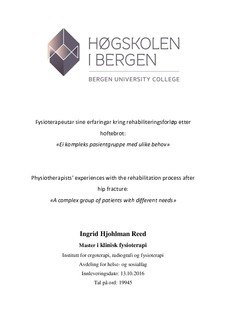| dc.contributor.author | Reed, Ingrid Hjohlman | |
| dc.date.accessioned | 2018-02-01T15:09:47Z | |
| dc.date.available | 2018-02-01T15:09:47Z | |
| dc.date.issued | 2016-10-13 | |
| dc.identifier.uri | http://hdl.handle.net/11250/2481942 | |
| dc.description | Masteroppgave i klinisk fysioterapi | en_GB |
| dc.description.abstract | Bakgrunn og føremål: Noreg er eit av dei landa i verda med høgast førekomst av hoftebrot. Hoftebrot rammar som oftast eldre, og medfører auka dødelegheit og funksjonshemming. Rehabilitering for å betre funksjon er viktig. Føremålet med denne studien var å få auka innsikt i pasientgruppa sitt rehabiliteringsforløp. Metode: I denne casestudien vart semistrukturerte intervju og fokusgrupper nytta til datainnsamling, 13 fysioterapeutar frå tre sjukehus og fem kommunehelsetenester, vart valt strategisk. Resultat: Pasientar med hoftebrot er ei kompleks gruppe med ulik behov for oppfølging. Kognitiv svikt og utryggleik hjå pasientane viste seg å vere utfordringar i rehabiliteringa. Sjukehusfysioterapeutane starta behandling fyrste postoperative dag. Kort liggetid kunne innskrenke deira moglegheiter til å gje behandling. Sjukehusfysioterapeutane erfarte avgrensa høve til å påverke utskriving og kvar pasientane skulle hamne etter utskriving. I dei undersøkte kommunehelsetenestene var pasientgruppa høgt prioritert til å kome i gang med fysioterapibehandling. Grad av fysioterapioppfølging og lengda av rehabiliteringa var generelt basert på fysioterapeutane sine faglege vurderingar kring pasientane sine behov. Mangel på ressursar, både ved sjukehus og i kommunehelsetenesta, medførte i enkelte tilfelle at pasientgruppa vart nedprioritert. Tverrfagleg samarbeid og samhandling mellom tenestenivå var sett på som viktig for eit heilskapleg forløp, men fungerte i ulik grad. Eigne behandlingsregimer ved sjukehus og prosjekt/tiltak knytt til rehabilitering i kommunane vart opplevd som fremjande for eit styrka rehabiliteringsfokus i tenesteapparatet. Konklusjon: Rammer for helsetenesta som gjer fysioterapeutar i stand til å gje personsentrert oppfølging basert på pasientane sine behov er viktig for gode rehabiliteringsforløp etter hoftebrot. Det same gjeld høve til å påverke dei ulike delane av rehabiliteringsforløpet. Det verkar viktig å fokusere på tverrfagleg samarbeid og møtestader i alle ledda av rehabiliteringsforløpet, samt styrke samhandlinga og kommunikasjon mellom tenestenivåa for at rehabiliteringsforløpet skal bli koordinert og heilskapleg. | en_GB |
| dc.description.abstract | Background and purpose: Norway is one of the countries with the highest incidence of hip fractures in the World. Hip fracture patients are often elderly, and the fracture increase the risk of death and functional impairment. Rehabilitation is important to regain function. The aim of this study was to get knowledge about hip fracture patients rehabilitation process. Method: In this case-study, semi-structured interviews and focus-group discussions were used to collect data. Thirteen physiotherapists from three hospitals and five primary health services, were selected for strategic sampling of informants. Results: Patients with hip fractures represent a complex group with different needs. Cognitive impairment and fear contributed to challenges in rehabilitation. The hospital physiotherapists started treatment the first postoperative day. Short length of stay could limit the physiotherapists possibility to give treatment. Physiotherapists experienced limited influence regarding discharge and the course of treatment after discharge. Hip fracture patients had high priority among the physiotherapists in the primary health service. The amount of physiotherapy treatment and the duration of the rehabilitation were mainly based on the physiotherapist’s evaluations concerning the patient’s needs. Lack of physiotherapy resources could result in the patients getting less treatment, both at the hospitals and in the primary care setting. Multidisciplinary teamwork and collaboration between the service levels was important to secure a holistic rehabilitation process. Adapted models of care at the hospitals, and rehabilitation-specifics increased the focus on rehabilitation in the primary health care services. Conclusion: To secure optimal rehabilitation it is important that the framework of the healthcare service allow the physiotherapists to give treatment according to the patients’ needs, and that they can influence the rehabilitation process. It seems important to focus on multidisciplinary teamwork and on collaboration and communication between service levels to secure holistic and coordinated rehabilitation. | en_GB |
| dc.language.iso | nno | en_GB |
| dc.publisher | Høgskulen på Vestlandet/ Western Norway University of Applied Sciences | en_GB |
| dc.rights | Attribution-NonCommercial-ShareAlike 3.0 Norway | * |
| dc.rights.uri | http://creativecommons.org/licenses/by-nc-sa/3.0/no/ | * |
| dc.subject.other | rehabiliteringsforløp | en_GB |
| dc.subject.other | rehabilitering | en_GB |
| dc.subject.other | hoftebrot | en_GB |
| dc.subject.other | pasientar | en_GB |
| dc.subject.other | pasientgruppe | en_GB |
| dc.subject.other | tverrfagleg samarbeid | en_GB |
| dc.subject.other | rehabilitation process | en_GB |
| dc.subject.other | rehabilitation | en_GB |
| dc.subject.other | hip fracture | en_GB |
| dc.subject.other | patients | en_GB |
| dc.subject.other | multidisciplinary teamwork | en_GB |
| dc.title | Fysioterapeutar sine erfaringar kring rehabiliteringsforløp etter hoftebrot: «Ei kompleks pasientgruppe med ulike behov» | en_GB |
| dc.title.alternative | Physiotherapists’ experiences with the rehabilitation process after hip fracture: «A complex group of patients with different needs» | en_GB |
| dc.type | Master thesis | en_GB |

